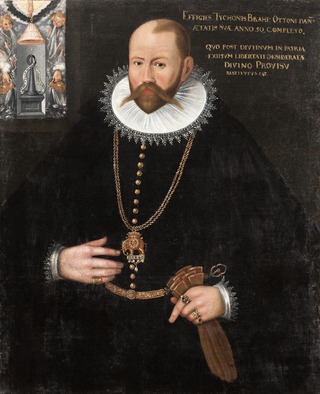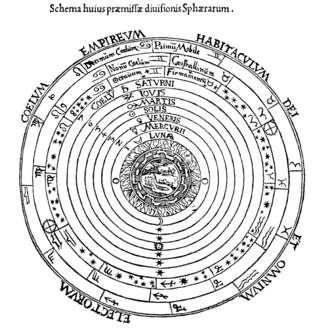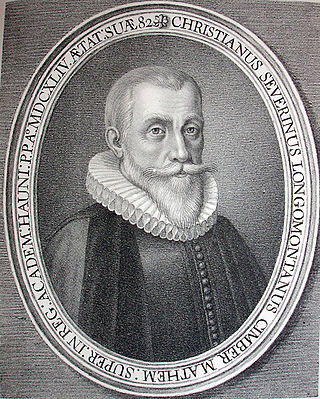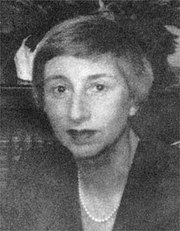
Johannes Kepler was a German astronomer, mathematician, astrologer, natural philosopher and writer on music. He is a key figure in the 17th-century Scientific Revolution, best known for his laws of planetary motion, and his books Astronomia nova, Harmonice Mundi, and Epitome Astronomiae Copernicanae, influencing among others Isaac Newton, providing one of the foundations for his theory of universal gravitation. The variety and impact of his work made Kepler one of the founders and fathers of modern astronomy, the scientific method, natural and modern science.

Tycho Brahe, generally called Tycho for short, was a Danish astronomer, known for his comprehensive and unprecedentedly accurate astronomical observations. He was known during his lifetime as an astronomer, astrologer, and alchemist. He was the last major astronomer before the invention of the telescope.

Uraniborg was a Danish astronomical observatory and alchemy laboratory established and operated by Tycho Brahe. It was the first custom-built observatory in modern Europe, and the last to be built without a telescope as its primary instrument.

The celestial spheres, or celestial orbs, were the fundamental entities of the cosmological models developed by Plato, Eudoxus, Aristotle, Ptolemy, Copernicus, and others. In these celestial models, the apparent motions of the fixed stars and planets are accounted for by treating them as embedded in rotating spheres made of an aetherial, transparent fifth element (quintessence), like gems set in orbs. Since it was believed that the fixed stars did not change their positions relative to one another, it was argued that they must be on the surface of a single starry sphere.

Christen Sørensen Longomontanus was a Danish astronomer.

The Constantinople observatory of Taqi ad-Din, founded in Constantinople by Taqi ad-Din Muhammad ibn Ma'ruf in 1577, was one of the largest astronomical observatories in medieval world. However, it only existed for a few years and was destroyed in 1580.
Astronomia nova is a book, published in 1609, that contains the results of the astronomer Johannes Kepler's ten-year-long investigation of the motion of Mars.

Michael Maestlin was a German astronomer and mathematician, known for being the mentor of Johannes Kepler. He was a student of Philipp Apian and was known as the teacher who most influenced Kepler. Maestlin was considered to be one of the most significant astronomers between the time of Copernicus and Kepler.

The Copernican Revolution was the paradigm shift from the Ptolemaic model of the heavens, which described the cosmos as having Earth stationary at the center of the universe, to the heliocentric model with the Sun at the center of the Solar System. This revolution consisted of two phases; the first being extremely mathematical in nature and the second phase starting in 1610 with the publication of a pamphlet by Galileo. Beginning with the publication of Nicolaus Copernicus’s De revolutionibus orbium coelestium, contributions to the “revolution” continued until finally ending with Isaac Newton’s work over a century later.

The Great Comet of 1577 is a non-periodic comet that passed close to Earth during the year 1577 AD. Being classed as non-periodic, indicated by its official designation beginning with "C", means that it is not expected to return. In 1577, the comet was visible to all of Europe, and was recorded by many contemporaries of the time, including the famous Danish astronomer Tycho Brahe and Turkish astronomer Taqi ad-Din. From his observations of the comet, Brahe was able to discover that comets and similar objects travel above the Earth's atmosphere. The best fit using JPL Horizons suggests that the comet is currently about 324 AU (48.5 billion km) from the Sun.
Hans Georg Herwart von Hohenburg was a Bavarian statesman and scholar, and a patron and correspondent of Johannes Kepler.
Helisaeus Roeslin or Helisäus Röslin was a German physician and astrologer who adopted a geoheliocentric model of the universe. Roeslin attended the University of Tübingen in order to become a physician. After becoming a physician Roeslin became very interested in astrology as well as predicting when the second coming of Christ would occur. He was one of five observers who concluded that the Great Comet of 1577 was located beyond the Moon. His representation of the comet, described as "an interesting, though crude, attempt," was among the earliest and was highly complex. Roeslin also came to the conclusion independently that it was the Sun not the Earth that was center of the Solar System. Today Helisaeus Roeslin is best remembered for his controversies and involvement with geo-heliocentric world systems and for writing books about astronomy. Some of his works consist of a Ratio Studiorum et operum, the Tabella, and De opere Dei creationis.

CorneliusGemma was a Flemish physician, astronomer and astrologer, and the oldest son of cartographer and instrument-maker Gemma Frisius. He was a professor of medicine at the Catholic University of Leuven, and shared in his father's efforts to restore ancient Ptolemaic practice to astrology, drawing on the Tetrabiblos.

Elisabeth (Elly) Dekker is a Dutch astronomer and science historian, specialising in the history of astronomy. She studied theoretical physics and astronomy at Utrecht University. In 1975 she obtained a PhD in astronomy at Leiden University with the thesis Spiral structure and the dynamics of flat stellar systems supervised by Hendrik C. van de Hulst. From 1978-1988 she was a curator of Museum Boerhaave in Leiden and afterwards an independent scholar. From 1993-1995 she was a Sackler fellow of the Royal Museums Greenwich. In 1998 she was awarded the Caird Medal for her work on the globe collection of the National Maritime Museum in Greenwich.

Comets have been observed by humanity for thousands of years, but only in the past few centuries have they been studied as astronomical phenomena. Before modern times, great comets caused worldwide fear, considered bad omens foreboding disaster and turmoil, for example the 1066 passage of Halley's Comet depicted as heralding the Norman conquest of England. As the science of astronomy developed planetary theories, understanding the nature and composition of comets became a challenging mystery and a large area of study.
The Vicarious Hypothesis, or hypothesis vicaria, was a planetary hypothesis proposed by Johannes Kepler to describe the motion of Mars. The hypothesis adopted the circular orbit and equant of Ptolemy's planetary model as well as the heliocentrism of the Copernican model. Calculations using the Vicarious Hypothesis did not support a circular orbit for Mars, leading Kepler to propose elliptical orbits as one of three laws of planetary motion in Astronomia Nova.
Peggy Aldrich Kidwell is an American historian of science, the curator of medicine and science at the National Museum of American History.
Judith Veronica Field is a British historian of science with interests in mathematics and the impact of science in art, an honorary visiting research fellow in the Department of History of Art of Birkbeck, University of London, former president of the British Society for the History of Mathematics, and president of the Leonardo da Vinci Society.
Clemency Montelle is a New Zealand historian of mathematics known for her research on Indian mathematics and Indian astronomy. She is a professor of mathematics at the University of Canterbury, and a fellow of the New Zealand India Research Institute of the Victoria University of Wellington.
Elske van Panhuys Smith is a Dutch-American astronomer, academic administrator, and author of books on astronomy. She has also been outspoken about discrimination against women in academia.












